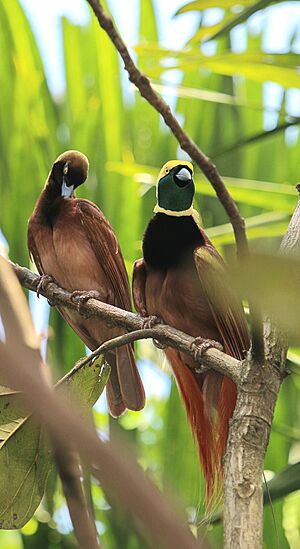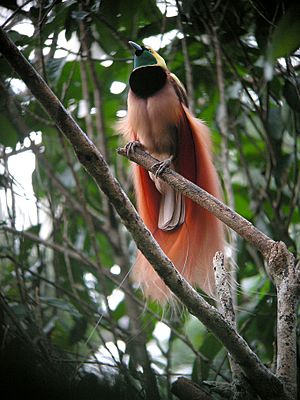Count Raggi's bird-of-paradise facts for kids
Quick facts for kids Count Raggi's bird-of-paradise |
|
|---|---|
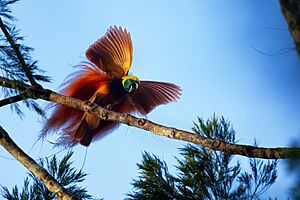 |
|
| Male raggiana bird-of-paradise displaying at a lek, Varirata National Park | |
| Conservation status | |
| Scientific classification | |
| Genus: |
Paradisaea
|
| Species: |
raggiana
|
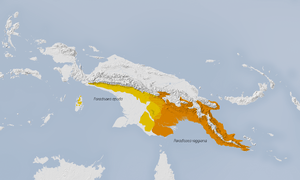 |
|
| Paradisaea raggiana Paradisaea apoda | |
| Synonyms | |
|
Gerrus paradisaea |
|
The Raggiana bird-of-paradise is a beautiful, large bird. It is also called Count Raggi's bird-of-paradise. This bird belongs to a special group of birds known as bird-of-paradises.
You can find these birds in southern and northeastern New Guinea. Local people there call it kumul or cenderawasih. The name "raggiana" honors a person named Francesco Raggi from Genoa.
This amazing bird is the national bird of Papua New Guinea. In 1971, it became a national symbol. You can even see it on the country's flag! The national rugby league team of Papua New Guinea is nicknamed "The Kumuls." This means "birds-of-paradise" in their local language, Tok Pisin.
Contents
Meet the Raggiana Bird-of-Paradise
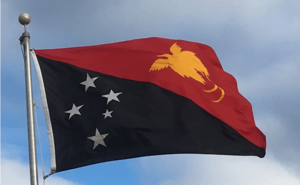
The Raggiana bird-of-paradise is about 34 centimetres (13 in) long. Its body is mostly a maroon-brown color. It has a grey-blue beak, yellow eyes, and grey-brown feet.
Male vs. Female Birds
Male birds are very colorful. They have a yellow head and a bright emerald-green throat. A yellow band separates their throat from their dark chest feathers. Males also have two long, black tail feathers. They have large, fancy feathers on their sides. These side feathers can be red or orange. This depends on where the bird lives.
For example, birds from the P. r. raggiana group have deep red side feathers. Another group, P. r. augustavictoriae, has apricot-orange feathers. This group is also known as the Empress of Germany's bird of paradise. Female birds are not as colorful. They are a plainer maroon-brown color. They do not have the long tail feathers or the fancy side plumes like the males.
Life and Habits of the Bird-of-Paradise
What Do They Eat?
These birds mainly eat fruits and small insects. They are very important for the tropical forests in New Guinea. When they eat fruit, they help spread the seeds. This helps new trees grow. They are especially important for some types of mahogany and nutmeg trees.
How They Reproduce
Raggiana birds-of-paradise have a special way of finding partners. Males gather in areas called leks. These are like display stages for females. Leks can be very large, up to 100 meters wide.
Inside the lek, males choose tall trees. They compete for the best spots to show off. On these branches, males clap their wings and shake their heads. This display is to impress the visiting females.
Nests and Eggs
The female bird builds a nest that looks like a bowl. She uses leaves, stems, ferns, and other plant parts. She lines the inside with soft, horsehair-like material. Nests are usually built 2 to 11 meters high in trees. If there are people nearby, the nests might be built even higher.
A female usually lays one or two eggs, but most often two. The eggs are a pinkish-buff color. It takes about 18 days for the eggs to hatch in the wild. In captivity, it takes about 20 days. Only the female bird takes care of the eggs and chicks.
Protecting the Raggiana Bird-of-Paradise
The Raggiana bird-of-paradise lives in the tropical forests of eastern New Guinea. There are many of them, so they are not considered endangered. They are listed as "Least Concern" on the IUCN Red List. This means they are not currently at risk of disappearing.
This bird is also listed on Appendix II of CITES. This agreement helps control the trade of certain animals. Local people sometimes use the birds' beautiful feathers for special headdresses. However, this practice does not threaten the birds' survival in the long run.



